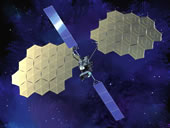 Japan has been launching a series of Engineering Test Satellites (ETS series) from ETS-I (KIKU No. 1) to ETS-VII (KIKU No. 7, or Orihime and Hikobosi), with the aim of developing satellite technology that meets the needs of the times. The KIKU No. 8 (ETS-VIII) was launched by an H-IIA launch vehicle on Dec. 18, 2006, is the eighth satellite in the series and is designed to cope with increasing communication demands for mobile devices such as portable phones.
Japan has been launching a series of Engineering Test Satellites (ETS series) from ETS-I (KIKU No. 1) to ETS-VII (KIKU No. 7, or Orihime and Hikobosi), with the aim of developing satellite technology that meets the needs of the times. The KIKU No. 8 (ETS-VIII) was launched by an H-IIA launch vehicle on Dec. 18, 2006, is the eighth satellite in the series and is designed to cope with increasing communication demands for mobile devices such as portable phones.The satellite weighs about three tons. Equipped with two large deployable antennas (reflectors) and two solar paddles, its end-to-end length is 40 meters. The area of one large deployable reflector is 19 m x 17 m, which is about the size of a tennis court. The satellite is one of the largest geostationary satellites in the world. Due to this enormous size, it enables mobile terminals such as cell phones that are about the same size as the current ones to directly communicate with the geostationary satellite that covers all of Japan, thus mobile communications will become smoother. The deployment technology of this reflector can be applied to large structures in space in the future.
